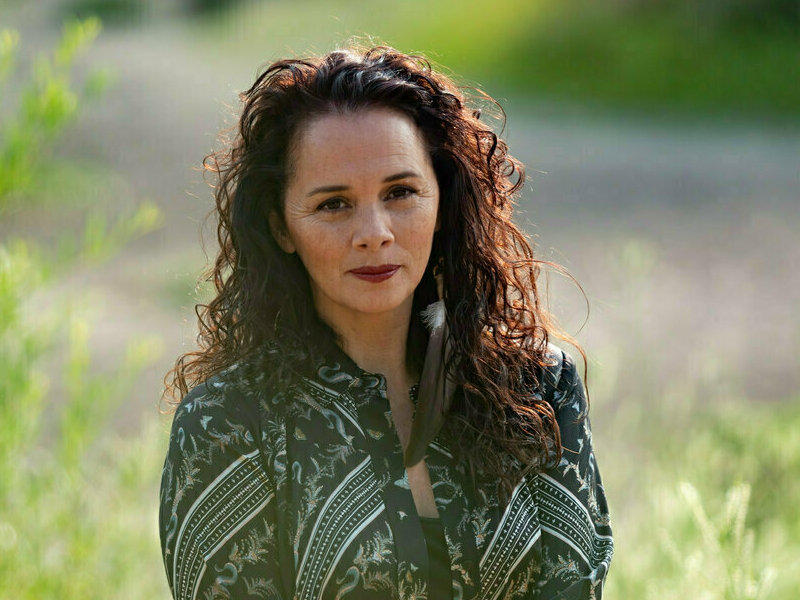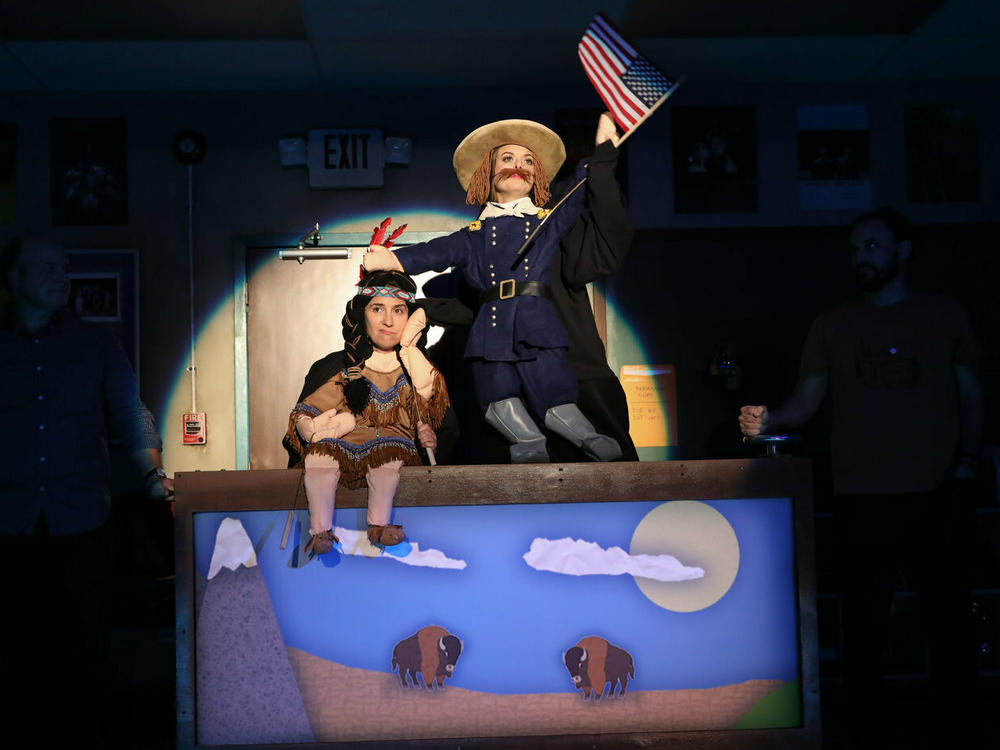Section Branding
Header Content
Native American playwright Larissa FastHorse takes on the 'wild mess' of Thanksgiving
Primary Content
The Macy's Thanksgiving Day Parade has been getting some updates. Four years ago, Native American playwright Larissa FastHorse and her creative partner Ty Defoe began consulting with parade organizers to make the annual event "less harmful" to Indigenous people. The first order of business was to get rid of the pilgrims.
"Things like the pilgrims are really difficult topics and subjects for folks that were on this coast and had their people almost entirely wiped out by those people, whether intentionally or unintentionally," FastHorse says.
Tom Turkey, the giant bird who traditionally opens the parade, used to roll along with two children dressed as pilgrims on his back. No longer. Now Tom wears a bow tie along with his top hat, as if he's attending a show. FastHorse also encouraged parade organizers, in 2020, to include for the first time a land acknowledgement, recognizing the Lenape people who inhabited the island of Manhattan prior to European settlement.
"Sixty million people heard it and everyone survived, as far as we know," FastHorse says. "It didn't traumatize any children to read a land acknowledgment on national television."
FastHorse, who is from the Sicangu Lakota Nation, describes the history of Thanksgiving as a "wild mess of muckiness." She unpacks that idea in The Thanksgiving Play, a satire that focuses on four well-meaning white people trying to put on a politically correct school production for Native American heritage month.
"It deals with all the things I wanted to deal with as far as the contemporary Indigenous experience," FastHorse says. "It's really showing us what it's like to be us. Like, what is it like to be myself in these rooms that are primarily white, that are primarily non-Indigenous in all ways."
The Thanksgiving Play ran earlier this year on Broadway, and is one of the 10 most-produced plays in the U.S., with runs at universities and community theaters. FastHorse still recalls the moment she knew the play would resonate with audiences.
"In the very first few minutes of the show, there's what I call the unifying joke that applies to everybody," she says. "And I remember sitting in the very first preview in New York before the Broadway production and the unifying joke was said and the audience burst out laughing. And I said to myself, 'This is the sound of your life changing.'"
Interview highlights
On the motivation for writing The Thanksgiving Play
The number one reason that I have spoken about before was casting. So I was told as a Native American playwright again and again that my plays that had primarily Native American actors were "uncastable," so I got really frustrated with that, because the way playwrights make a living on playwriting is not just on the first play, but on that play being produced again and again. That's the one way it becomes a little bit sustainable to be a playwright. And that wasn't happening for me. And that's the feedback I got. So I was frustrated. I wasn't thrilled about that because I know there's so many fantastic Native American actors out there. But I gave myself the challenge of writing a play that was for white-presenting people.
On being a comedy writer
People so often want Native work to be dark and dramatic. ... If you look at my plays on the cover page, it almost always says like "a satirical comedy" or "a farce" or something like that. ... I'm a joke writer. I can write jokes all day long. It's fascinating, though. People read my plays, including Thanksgiving Play, and they'd say, "Well, I laughed. Is that OK?" Like, "Yes, it's a comedy. It's a satire. Like, of course you're supposed to laugh." So now I have to actually put it on the title page. And I think it's just there's this fear of laughing at Indigenous ideas and characters.
On having trouble getting funding earlier in her career
I spent many years of my life living below the poverty level when I was considered a successful playwright. ... I'm really fortunate people fund me now and fund me well. But it took a really long time. And it's exhausting. ...
[Funders] wanted me to do "Native American" work. I was like, "Well, it is. If I'm doing it, it's Native American work. If it's on Broadway, if it's on a reservation, whatever it is, it's Native American work because it's mine."
On the sense of urgency in the efforts to diversify Broadway
You can't just undo decades and decades of misrepresentation or invisibility in a couple of years. ... There's been fantastic attention paid to the fact that there has been this erasure of other voices, nonwhite voices on Broadway. So the attention is great. I think we still are working on the follow through. We're still working on getting the same kind of capitalization and support and time to develop our shows. I've been pushed under a sense of urgency that, "We have to do this play right now!" And I appreciate the slot, and I'll take it, but maybe the play would benefit from the same amount of time that a white playwright gets. ...
The Broadway system, the commercial theater system, hasn't included all of us before a couple of years ago. So we're still kind of getting caught up into the system and figuring out, well, what kind of support do we need? What's been missing? Where are our big blind spots? Where are the empty holes where we don't have the casting outreach? We don't have the cultural support outreach. We don't have the audience outreach. We're just finding those holes that exist on Broadway that need to be filled, and they're going to take a little bit of time. But I'm thrilled that so many plays are getting out there and are getting on stage and are getting to be seen and we're going to prove that we do all right. We can make money, which is what Broadway is about, right? But we can also entertain people and appeal to a broad audience.
On changes she's made to the forthcoming Peter Pan musical on Broadway to address the racism toward Native people
Neverland is a magical place, and it's a place where no one ever grows old. It's a place of fairies and pirates and dancing animals and things. And so just the idea of Indigenous or traditionally Native American people like Tiger Lily and her tribe being there is already just a problem. We're real people. Why are we in Neverland? ...
So what I chose to do with this play is I took Tiger Lily and I kept her name, because it's iconic and beloved, and she's now the leader of this tribe of people. But each of those people is the last of an extinct culture somewhere in the world. So they come here because they never grow old, so they can preserve their culture in a place where they're safe and hope that one day they can return to this world and bring their culture with them. And so I use the magic of Neverland as a positive for these people, as somewhere where they can survive and preserve and grow and keep their culture going until they find another home for it.
Ann Marie Baldonado and Susan Nyakundi produced and edited this interview for broadcast. Bridget Bentz, Molly Seavy-Nesper and Beth Novey adapted it for the web.
Copyright 2023 Fresh Air. To see more, visit Fresh Air.


